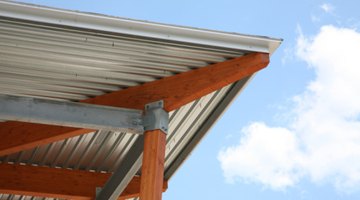How to Square a Metal Roof
When framing a roof, whether metal, shingled, or shaked, it must be square. A “square” roof is one in which all the corners are constructed at 90° angles. When covering the roof with plywood or metal sheets, it's necessary to fit the materials to the rafters exactly.

Fortunately, one can frame square rafters fairly simply, using a framing square and a construction calculator. Learning how to square rafters correctly, will help a metal roof installation go smoothly.
Things You Will Need
- Framing square
- Construction calculator
- Measuring tape
- Ladder
- Rafters
- Circular saw
- Hand saw
Preparation
-
Make sure the walls are square. Do this by measuring three feet out from the corner along one wall, and marking it accurately. Starting from the same corner, measure four feet out along the other wall, and mark it. Measure diagonally between the two marks, this should equal a measurement of five feet.
-
Measure the span of the roof. This is the width of the building between both outside supporting walls. Write it down.
-
Record the run measurement, which is 1/2 of the span.
-
Measure and record the roof’s rise. This is the height of the roof from the center of the span to the top of the roof line. If a gable truss is not in place to measure, remember: you know how tall the roof is going to be.
-
Determine the line length measurement, which stretches from the outside of your supporting wall to the top of the rise. If the span and the rise is known, apply the Pythagorean theorem to figure the line length.
-
Find out the pitch needed for the roof. The pitch is the amount of the roof’s slope and is generally determined by local code requirements. Check with the city’s building commission for information.
Measuring for Pattern Rafters
-
Choose a straight rafter board, with no bending.
-
Lay out the rafter. Place the square on the rafter’s end. For a roof with 8/12 pitch, find 8-inches on the shorter arm of the square (the tongue), and 12-inches on the longer end (the blade). Mark these points on the rafter.
-
Measure between the tongue and blade as the square lays on the rafter. (The result in this example is 14- 7/16).
-
Multiply this measurement by the run of the structure; don’t include the roof’s overhang.
-
Add the overhang measurement to that number. This is as long as the rafter needs to be.
Cutting
-
To make the “plumb cut,” or the cut at which the rafter will sit on the ridge plate, place a square on the upper end of the rafter with 8-inches on the tongue’s outside edge, and the 12-inches on the blade. With a pencil, trace the back edge of the tongue. Cut along here for the plumb cut.
-
Measure from the plumb cut line to the line length measurement determined earlier. Don’t include the overhang yet, and subtract half the width of the ridge board, probably about 3/4 inch. Place a square at this point in the same position used to mark the plumb cut. Draw another line down the outer edge of the tongue.
-
Add the length of the overhang beyond the plumb mark and mark it. Holding the square in reverse, so that the corner is sticking up and the blade is pointing down, find 8-inches on the tongue and draw the line down the outer edge. This will mark the “heel cut.”
-
Cut the rafter at both the first plumb cut marked, and at the tail cut.
-
Position the square on the second plumb cut line marked. The tongue end will be closest. Taking the thickness of the building’s wall into account, mark the notch that is formed in the angle of the square. This is the “bird’s mouth,” and will fit over the wall or wall plate of the roof. Begin cutting the notch with a circular saw, but be sure to finish with a hand saw for accuracy. Make sure the rafter fits the roof exactly. If it does, use this as a pattern to work from.
Tip
•If you are a novice, practice with a framing square on a small project.
Warning
Wear safety glasses and a harness when roofing.
The Drip Cap
- When framing a roof, whether metal, shingled, or shaked, it must be square.
- This is the width of the building between both outside supporting walls.
- Determine the line length measurement, which stretches from the outside of your supporting wall to the top of the rise.
- Place the square on the rafter’s end.
- Multiply this measurement by the run of the structure; don’t include the roof’s overhang.
- Holding the square in reverse, so that the corner is sticking up and the blade is pointing down, find 8-inches on the tongue and draw the line down the outer edge.
- Position the square on the second plumb cut line marked.
- This is the “bird’s mouth,” and will fit over the wall or wall plate of the roof.
- Make sure the rafter fits the roof exactly.
References
Writer Bio
Danica Sorber has been a commercial copywriter since 2004. She has experience writing online content for websites such as Blended People of America and Connections Magazine. Sorber has a Bachelor of Science in biblical counseling from Baptist Bible College and Seminary.
Photo Credits
- Jupiterimages/Photos.com/Getty Images
- Jupiterimages/Photos.com/Getty Images
More Articles



